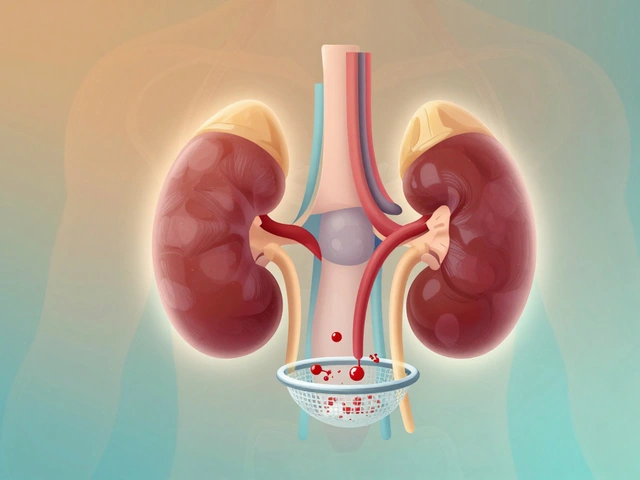The Origins of Torsemide: A Breakthrough in Diuretic Therapy
As a passionate blogger, I am always on the lookout for fascinating stories and discoveries in the world of medicine. Today, I would like to discuss the history of torsemide, a vital medication in the treatment of various medical conditions. The story of torsemide begins in the early 1980s when a team of researchers at the pharmaceutical company Roche set out to develop a new, more effective diuretic. Diuretics are medications that help the body get rid of excess water and salt, and they play a critical role in the management of conditions such as heart failure, kidney disease, and high blood pressure.
After years of research and experimentation, the team at Roche successfully synthesized torsemide in 1983. This new medication was found to be more potent and have a longer duration of action than other diuretics available at the time. This breakthrough would pave the way for a new era in diuretic therapy, offering patients and healthcare providers a more effective and convenient option for managing fluid retention and other related medical issues.
Torsemide's Journey Through Clinical Trials
Before torsemide could be made available to the public, it had to undergo a series of rigorous clinical trials to evaluate its safety and efficacy. The first clinical trials for torsemide began in the late 1980s and continued into the early 1990s. These trials compared torsemide to other diuretics, such as furosemide and bumetanide, in the treatment of various medical conditions.
Overall, the results of these clinical trials were very promising. Torsemide was found to be as effective, if not more so, than other diuretics in the treatment of fluid retention and high blood pressure. Furthermore, torsemide was shown to have a more predictable and consistent effect on urine output and electrolyte balance, making it a more reliable option for patients and healthcare providers. With these positive results in hand, torsemide was well on its way to becoming a widely used medication in the field of diuretic therapy.
FDA Approval and Market Introduction
In 1993, torsemide received approval from the U.S. Food and Drug Administration (FDA) for the treatment of edema associated with congestive heart failure, kidney disease, and liver disease. The following year, torsemide was also approved for the treatment of high blood pressure. With these approvals in place, torsemide was officially introduced to the market under the brand name Demadex in 1995.
Since its introduction, torsemide has become a popular choice among healthcare providers for the management of fluid retention and high blood pressure. Its unique pharmacological properties, such as its potency and long duration of action, have made it a valuable addition to the diuretic therapy toolkit.
Comparing Torsemide to Other Diuretics
As I mentioned earlier, torsemide is often compared to other diuretics, such as furosemide and bumetanide. While all three medications belong to the same class of drugs known as loop diuretics, there are some key differences that set torsemide apart.
One of the main advantages of torsemide is its longer duration of action. Torsemide's effects can last up to 24 hours, while the effects of furosemide and bumetanide typically last between 6 and 8 hours. This means that patients taking torsemide may require fewer doses per day, which can improve adherence to treatment and overall quality of life. Additionally, torsemide has been shown to have more predictable effects on urine output and electrolyte balance, making it a more reliable option for patients and healthcare providers.
Modern Uses of Torsemide: Expanding the Scope of Diuretic Therapy
Over the years, torsemide has continued to gain popularity as a first-line treatment for fluid retention and high blood pressure. Recently, researchers have also begun to investigate the potential benefits of torsemide in other medical conditions, such as diabetes and metabolic syndrome. Some studies have suggested that torsemide may help improve blood sugar control and reduce the risk of cardiovascular complications in these patient populations.
While more research is needed to fully understand the potential benefits of torsemide in these areas, it is clear that this medication has a bright future ahead. As our understanding of torsemide continues to grow, so too does its potential to improve the lives of patients suffering from a wide range of medical conditions.
Conclusion: The Ongoing Legacy of Torsemide
In conclusion, the history of torsemide is a testament to the power of innovation and perseverance in the field of medicine. From its initial discovery to its modern applications, torsemide has come a long way, offering patients and healthcare providers a more effective and convenient option for diuretic therapy. As we look to the future, I am excited to see how torsemide will continue to evolve and improve the lives of patients around the world.




Kristin Violette on 29 May 2023, AT 14:13 PM
The pharmacokinetic profile of torsemide showcases a fascinating interplay between bioavailability and renal clearance that underscores its clinical versatility.
The drug’s high lipophilicity facilitates consistent tubular secretion, thereby reducing interpatient variability.
Moreover, its extended half-life compared to furosemide aligns well with chronotherapy principles, allowing for once-daily dosing in many heart failure regimens.
The initial discovery phase at Roche leveraged structure‑activity relationship (SAR) analyses that pinpointed the sulfonylurea moiety as a key determinant of loop activity.
Subsequent phase‑II trials incorporated stratified randomization to isolate covariates such as eGFR and concomitant ACE‑inhibitor use.
Statistical modeling from those datasets revealed a modest but significant reduction in rehospitalization rates versus legacy diuretics.
Importantly, the electrolyte homeostasis observed with torsemide tends to be more predictable, mitigating the risk of hypokalemia in vulnerable cohorts.
From an inclusive healthcare lens, this predictability translates into fewer dose adjustments and improved adherence across diverse socioeconomic groups.
The drug’s metabolic pathway via CYP2C9 also opens avenues for pharmacogenomic tailoring, a frontier that aligns with precision medicine initiatives.
In the realm of comparative effectiveness research, head‑to‑head meta‑analyses have consistently reported comparable natriuretic efficacy with a superior side‑effect profile.
Clinicians have noted that patients often report a subjective sense of “lighter legs,” a qualitative metric that, while anecdotal, bears relevance to quality‑of‑life assessments.
The FDA’s accelerated approval in 1993 reflected a robust benefit‑risk calculus, supported by multicenter double‑blind studies.
Since its market entry as Demadex, post‑marketing surveillance has not flagged any unexpected safety signals, reinforcing the drug’s favorable risk matrix.
Emerging investigations into torsemide’s potential anti‑fibrotic properties suggest a role beyond diuresis, particularly in myocardial remodeling contexts.
Overall, the trajectory of torsemide from bench to bedside exemplifies how iterative scientific inquiry can yield a therapeutic agent that serves both efficacy and patient‑centered care.